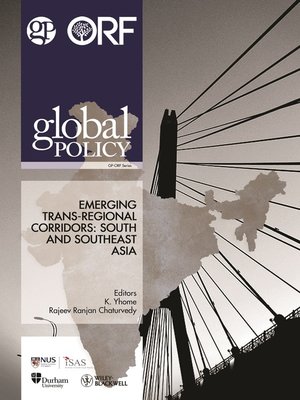Emerging Trans-Regional Corridors
ebook ∣ South and Southeast Asia · GP and ORF e-

Sign up to save your library
With an OverDrive account, you can save your favorite libraries for at-a-glance information about availability. Find out more about OverDrive accounts.
Find this title in Libby, the library reading app by OverDrive.



Search for a digital library with this title
Title found at these libraries:
| Library Name | Distance |
|---|---|
| Loading... |
Editors: K. Yhome and Rajeev Ranjan ChaturvedyAsia's rise on the global economic map has necessitated greater interconnection within, and with, the outside world. This development of interconnection is taking place between nations as well as across regions and sub-regions in Asia. The concept 'economic corridor' is used to explain this phenomenon. Economic corridors link economic agents within a country or across regions by providing connection between economic nodes or hubs where economic resources and actors are concentrated. Economic corridors are seen as a "catalyst for regional integration" and a "driver for inclusive growth" by bringing in lagging regions into the growth process. They also provide "spatial focus" for regional cooperation initiatives by facilitating priorities of regional projects as well as access to global production chains. The basic emphasis that lies in the creation of economic corridors is to ensure that within a contiguous area, there is potential to attract investments and generate economic activity.The volume looks at four specific proposed and/or planned projects of trans-regional economic corridors connecting South Asia and Southeast Asia, and through them to other regions. The proposed Indo-Pacific Economic Corridor will connect the Indian and the Pacific Oceans through South and Southeast Asian littorals. China's Maritime Silk Road initiative plans to link East Asia to Africa and Europe through South and Southeast Asia. The four-nation Bangladesh, China, India and Myanmar Economic Corridor plans to connect China's southwest region to India's eastern region through Bangladesh and Myanmar. Lastly, the Trans-Himalayan Economic Corridor will link South and Southeast Asia to Central Asia through Nepal. While economic corridors are of course judged on their economic merit, there are also strategic and security issues associated with these corridors, as is evident from the papers in this volume.ContentsIntroductionEmerging Trans-Regional Corridors: Perspectives from South and Southeast AsiaK. Yhome and Rajeev Ranjan ChaturvedyLinking South and Southeast AsiaConnecting South Asia with Southeast Asia: A Reality CheckTariq A. KarimIndia: The Bridge Linking South and Southeast AsiaSreeradha DattaProjects, Proposals and PlansIndo-Pacific Economic Corridor: A Vision in ProgressShankari SundararamanThe 21st Century Maritime Silk RoadRajeev Ranjan ChaturvedyThe BCIM Economic Corridor: Prospects and ChallengesK. YhomeTrans-Himalayan Economic Corridor: Nepal as a GatewayMadhukar S.J.B. RanaEconomic and Security ImperativesThe MSR Economic Corridor: Character and ImplicationsAmitendu PalitChina's MSR: A Strategic View from IndiaDarshana M. BaruahChina, ASEAN and the MSR: A Southeast Asian PerspectiveMartin A. Sebastian







